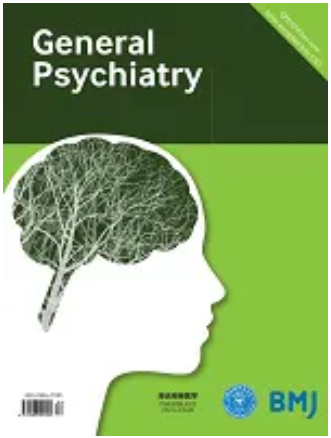Network analysis of suicide ideation and depression–anxiety symptoms among Chinese adolescents
IF 5.3
3区 医学
Q1 PSYCHIATRY
引用次数: 0
Abstract
Background The co-occurrence of depression and anxiety among adolescents is typically associated with suicide ideation. Aims The study aimed to investigate the symptom-level relationship between suicide ideation and the comorbidity of depression and anxiety. Methods 1501 adolescents aged 12–19 years were assessed using the Patient Health Questionnaire (PHQ-9) and the Generalized Anxiety Disorder Scale, and 716 adolescents who scored ≥5 on both scales were selected as participants. Network analysis was used to identify the network structure of depressive symptoms and anxiety symptoms. Participants were categorised into either the suicide ideation or non-suicide ideation groups based on their scoring on the suicide-related item in PHQ-9. A comparison was made between the depression–anxiety symptom networks of the two groups. Results ‘Restlessness’, ‘sad mood’ and ‘trouble relaxing’ were the most prominent central symptoms in the depression–anxiety symptom network, and ‘restlessness’, ‘nervousness’ and ‘reduced movement’ were the bridge symptoms in this network. ‘Sad mood’ was found to be directly related to ‘suicide ideation’ with the highest variance. The network structure was significantly different in properties between the suicide ideation group and the non-suicide ideation group, with ‘restlessness’ and ‘sad mood’ exhibiting significantly higher influence in the network of the suicide ideation group than that in the non-suicide ideation group. Conclusion Restlessness and sad mood could be targeted for the intervention of depression–anxiety symptoms among adolescents with suicide ideation. Data are available upon reasonable request.中国青少年自杀意念与抑郁焦虑症状的网络分析
背景 青少年同时患有抑郁和焦虑症通常与自杀意念有关。目的 本研究旨在探讨自杀意念与抑郁和焦虑共存之间的症状水平关系。方法 使用患者健康问卷(PHQ-9)和广泛性焦虑症量表对 1501 名 12-19 岁的青少年进行了评估,并选取了在两个量表中得分均≥5 分的 716 名青少年作为研究对象。通过网络分析确定了抑郁症状和焦虑症状的网络结构。根据参与者在PHQ-9自杀相关项目上的得分,将他们分为有自杀意念组和无自杀意念组。我们对两组参与者的抑郁焦虑症状网络进行了比较。结果 "烦躁不安"、"悲伤情绪 "和 "难以放松 "是抑郁-焦虑症状网络中最突出的中心症状,而 "烦躁不安"、"紧张 "和 "运动减少 "则是该网络中的桥接症状。悲伤情绪 "与 "自杀意念 "直接相关,方差最大。自杀意念组和非自杀意念组的网络结构在性质上有明显差异,其中 "烦躁不安 "和 "悲伤情绪 "在自杀意念组网络中的影响力明显高于非自杀意念组。结论 烦躁不安和悲伤情绪可作为干预有自杀意念青少年抑郁焦虑症状的目标。如有合理要求,可提供相关数据。
本文章由计算机程序翻译,如有差异,请以英文原文为准。
求助全文
约1分钟内获得全文
求助全文
来源期刊

General Psychiatry
医学-精神病学
CiteScore
21.90
自引率
2.50%
发文量
848
期刊介绍:
General Psychiatry (GPSYCH), an open-access journal established in 1959, has been a pioneer in disseminating leading psychiatry research. Addressing a global audience of psychiatrists and mental health professionals, the journal covers diverse topics and publishes original research, systematic reviews, meta-analyses, forums on topical issues, case reports, research methods in psychiatry, and a distinctive section on 'Biostatistics in Psychiatry'. The scope includes original articles on basic research, clinical research, community-based studies, and ecological studies, encompassing a broad spectrum of psychiatric interests.
 求助内容:
求助内容: 应助结果提醒方式:
应助结果提醒方式:


